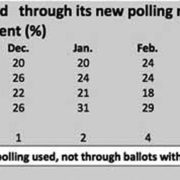It seems so, or the Social Weather Station’s collation of data has fallen under the control of Manuel Roxas and Leni Robredo’s operatives, so that in the past two surveys their voter-preference ratings have inexplicably surged, while those of Vice President Jejomar Binay and Ferdinand Marcos, Jr. have fallen.
This could be done because of SWS’s new polling method, which would allow votes for presidential candidate Binay and vice presidential contender Marcos, Jr. – whose ratings have dropped for a reason – to be rejected on grounds, as the SWS itself describes it, of “invalid markings.”
Only in its last two surveys did the SWS adopt this new method, which it had never used before (not in its 2010 polls), for determining how many of its respondents choose particular candidates.
Instead of the standard procedure of the pollster writing down the name of the candidate the respondents say they will vote for (and therefore, accepting these at face value), the new method asks the respondents to mark their choice in a ballot, privately, and put it in a container.
On the surface, this appears to be an appropriate method. But in reality, it merely mimics how election cheating has been undertaken for decades in this country. This is done during the counting of the ballots, with the votes for the candidate who is being cheated declared invalid or are rejected. At least, in the low-tech way of counting ballots in the past, candidates were allowed to put in place their own poll-watchers who could raise a protest every time a certain vote for their candidates was rejected.
The counting of the “ballots” by the SWS, though, takes place in hidden rooms, with no third-party observing the process.
In its new method of polling, ballots with “invalid marks,” SWS itself explains, are rejected. It has not explained what qualifies as an “invalid” mark, however. It has neither reported its process for counting the ballots nor disclosed which candidates were chosen in such rejected ballots.
The number of such rejected ballots is not insignificant: 7 percent in its March 30 to April 2 survey and 5 percent in the April 18 to 20 polling. (This excludes the 3 percent of respondents in the two surveys who replied that they had not decided whom to vote for.)
It does not seem coincidental then that when SWS used this new method of polling, and 7 percent and 5 percent of ballots were rejected, Binay’s ratings plunged from 24 percent in early March to 20 percent in late March, and to just 14 percent in the last poll conducted in early April.
If the 7 percentage points of “rejected” ballots in the March 30 – April 2 poll were for Binay, his ratings would not be at 20 percent but at 27 percent, at par with Duterte’s.
For the manipulators of the SWS data, only 5 percent “rejected votes” were needed to bring Binay’s ratings to 14 in the most recent poll.
In contrast, a survey from April 21 to 23 by a major pollster commissioned privately (which is expected to be released publicly soon), but which did not use SWS’s method of polling through ballots but by the standard way of the interviewer writing down the respondents’ replies.
It also does not seem coincidental that when SWS used this new method of polling, Robredo’s rating jumped from 19 percent in March to 26 percent in April. The 5 percent rejected votes in the April poll were likely those for Marcos and Francis Escudero, which explains why the two candidates’ steady ratings – Marcos’ even surged from 19 percent in December to 26 percent in March – were broken only when the SWS used its new method of polling, and rejected 4 to 5 percent of the ballots.
Roxas and Robredo obviously have made manipulated polls as a major part of their electoral strategies, since without these to project that surveys from reputable pollsters show their political support, massive cheating on May 9 elections would be so obvious – far from the polling results – as to provoke public outrage.
The use of ballots and SWS’ power to reject certain ballots is not the only new way it employs for its polls, which is obviously intended to pull down Binay’s ratings. In a previous column (“The SWS mobile ‘survey’ and an Indonesian tycoon’s potential, crucial role in our elections, April 10, 2016), I exposed that the SWS’s new type of polling it calls the “SWS-Bilang Pilipino Mobile Survey” isn’t at all a legitimate poll since it involves a permanent panel of about 750 respondents, whose views the SWS collects through their SMS messages via cellphones provided by the Indonesian-owned PLDT.
Only the SWS and PLDT know the cellphone numbers of these respondents and one easy way of manipulating this panel’s responses would be to send them messages favorable to a certain candidate, before they even receive the question which candidate they prefer.
SWS’s partners in these two very questionable polling methods are entities both controlled by the Indonesian tycoon Anthoni Salim: Smart Communications in the “Bilang Pilipino Mobile Survey” and the newspaper BusinessWorld in the ballot-based polling, in which the SWS rejects certain ballots.
It is certainly not coincidental that in both of these two questionable polls, Binay’s ratings were pulled below Roxas’ at 15 percent in the “Mobile Survey’s” on April 13, and 14 percent in the ballot-based April 18 purported “poll.”
In contrast, the other major firm PulseAsia, which uses the standard method of getting responses in its April 12 -17 poll, reported Binay as staying in third place in the contest, with a 19 percent rating.
Roxas’ and Robredo’s rivals should demand that the Comelec investigate what could be the biggest propaganda scheme of this election. (ManilaTimes.net)






